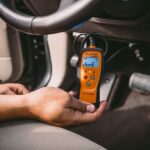Experiencing transmission trouble and seeing the 0760 Obd2 Code pop up? This fault code, indicating an “OD Solenoid Circuit Error,” can be a cause for concern, potentially leading to your vehicle’s transmission going into limp-in mode. Let’s break down what this code means, what causes it, and how you can approach diagnosing the problem.
The 0760 OBD2 code specifically points to an issue within the Overdrive (OD) solenoid circuit in your vehicle’s transmission. When your vehicle’s Powertrain Control Module (PCM) detects a problem in this circuit, it triggers the P0760 code and often initiates a fail-safe condition known as “limp-in mode.” Limp-in mode is designed to protect your transmission from further damage by limiting its operation.
Symptoms of a P0760 Code
One of the most noticeable symptoms of the 0760 OBD2 code is that your transmission may be stuck in limp-in mode, typically meaning it’s locked in 4th gear. This will result in several performance issues:
- Sluggish Acceleration: Starting from a stop will feel significantly slower and require more effort as the transmission is not using lower gears for initial acceleration.
- High RPMs at Speed: At highway speeds, you’ll notice higher engine RPMs than usual because the overdrive gear is not engaging. This also leads to decreased fuel efficiency.
- Transmission Stuck in One Gear (Usually 4th): The vehicle will primarily operate in a single gear, lacking the normal smooth transitions between gears.
- Check Engine Light: The check engine light will illuminate on your dashboard, signaling that a fault code has been registered.
It’s important to note that while restarting your engine might temporarily clear the limp-in condition, the problem will likely return and the 0760 OBD2 code will reappear if the underlying issue persists. Driving for extended periods in limp-in mode is not recommended as it can lead to overheating of the transmission.
Potential Causes of the P0760 Code
The 0760 OBD2 code indicates a problem within the OD solenoid circuit, and there are three primary categories of potential causes:
- Faulty Overdrive Solenoid Coil: The solenoid itself might have an internal open circuit, meaning the coil wire within the solenoid is broken. This prevents the solenoid from functioning correctly.
- Wiring Issues: Problems in the wiring between the OD solenoid and the PCM are common culprits. This can include:
- Open Circuit: A break in the wire, preventing electrical current flow.
- Short Circuit: The wire may be shorted to ground or another wire, disrupting the intended circuit.
- Connector Problems: Corroded, loose, or damaged connectors at either the solenoid or PCM can interrupt the circuit.
- PCM Malfunction: In less frequent cases, the issue might stem from a faulty PCM. Specifically, the solenoid driver chip within the PCM that controls the OD solenoid could be malfunctioning, failing to properly activate the solenoid or detect the feedback voltage spike.
Diagnosing and Troubleshooting the P0760 Code
Pinpointing the exact cause of the 0760 OBD2 code requires a systematic approach. A good first step, and often surprisingly effective, is to check the transmission wiring harness connections.
Step 1: Inspect and Reseat the Transmission Wiring Harness
A loose or corroded connection in the wiring harness can easily trigger a 0760 OBD2 code. Follow these steps to inspect and reseat the harness connectors:
- Turn Off the Ignition: Ensure the vehicle’s ignition is completely turned off before proceeding with any electrical work.
- Locate the Transmission Wiring Harness Connectors:
- PCM Connector: Find the PCM, typically located in the engine bay. Identify the transmission harness connector. It’s usually one of the end connectors and may have a green marking. Disconnect this connector.
- Transmission Connector: Locate the main electrical harness connector on the transmission itself. This is usually on the driver’s side of the transmission, a 23-pin connector positioned above the oil pan rail.
- Inspect the Connectors: Carefully examine both the PCM and transmission harness connectors for:
- Bent or Damaged Pins: Look for any pins that are bent, broken, or pushed back into the connector housing.
- Corrosion or Contamination: Check for signs of rust, dirt, or moisture within the connectors.
- Reseat the Connectors: Reconnect both the PCM and transmission harness connectors, ensuring they are firmly seated and locked in place. Listen for a click to confirm they are properly engaged.
Alt text: Close-up of a transmission wiring harness connector, highlighting the locking lever and secondary latch mechanism.
Understanding the Transmission Harness Connector Locking Mechanism:
The transmission harness connector typically features a locking lever and a secondary latch to ensure a secure connection.
- Disconnecting: To disconnect, you’ll first need to release the secondary lock (often a red plastic piece). Slide this lock to disengage it. Then, locate the latch on the locking lever (usually on the driver’s side). Push the latch inwards towards the transmission to release the locking lever. Rotate the lever downwards and lift the harness off.
- Reconnecting: When reconnecting, ensure the locking lever is in the open (downward) position. Push the connector straight onto the transmission connector until it’s fully seated. Rotate the locking lever upwards until it latches, securing the connection. Finally, slide the secondary lock back into its locking position.
If reseating the connectors resolves the issue, you’ve likely fixed a connection problem. If the 0760 OBD2 code persists, further diagnosis is necessary to pinpoint whether the problem lies with the solenoid itself, the wiring, or the PCM. Further troubleshooting may involve using a multimeter to test circuit continuity and solenoid resistance, which may require specialized knowledge and tools. If you’re not comfortable performing these tests, it’s recommended to seek assistance from a qualified automotive technician to accurately diagnose and repair the 0760 OBD2 code.
